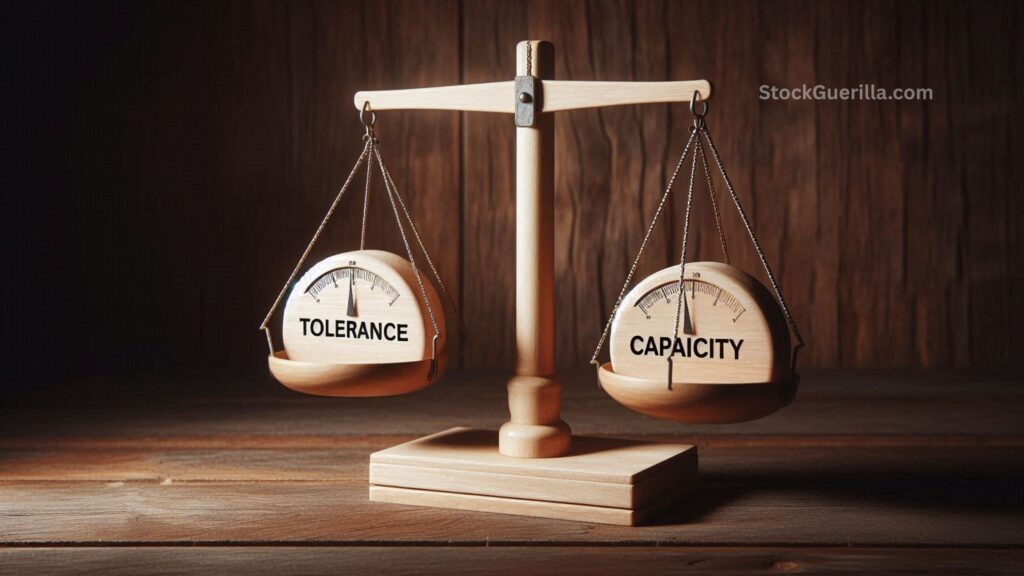How to Assess Risk Tolerance in Investing?
When we talk about risk tolerance, we’re really talking about how comfortable you are with the idea of losing money when you invest. Everyone handles risk differently, so investors are often grouped into three types: aggressive, moderate, and conservative.
We all know the stock market goes up and down for many reasons. That means every investment comes with some level of risk. Some are more unpredictable and risky, while others are more stable. One of the most important things to think about when choosing where to invest your money is how much risk you’re willing to take.
So, What Exactly is Risk Tolerance?
In simple terms, risk tolerance is how much loss you’re willing to accept in your investments. Let’s break it down with an example:

Suppose Investor A wants to invest ₹10,000 for two years. They decide they’re only comfortable risking up to ₹1,000 (or 10%). So, they look for an investment option where the past losses haven’t gone beyond that.
This shows how knowing your risk tolerance helps you choose the right investments and protects you from bigger losses—especially when markets become unpredictable.
How Risk Tolerance Plays Out in Real Life
Understanding your risk tolerance isn’t just a one-time thing—it really shows during tough times. For example, when markets crashed in March 2020 due to COVID-19, many people panicked and sold their stocks. These investors probably had a low risk tolerance. But others held onto their investments or even bought more during the dip—and were rewarded when markets bounced back in 2021.
A similar thing happened in 2022 when rising interest rates shook both stock and bond markets. Again, it was a true test of how much risk investors could actually handle.
What Affects Your Risk Tolerance?
Not everyone is the same when it comes to risk. Some people are okay taking big chances for higher returns, while others prefer to play it safe. Here are some key things that influence how much risk you’re comfortable with:

1. Income
If you earn more and have savings to fall back on, you might be okay taking bigger risks. But if your income is limited, you’ll likely prefer safer investments.
2. Time Horizon
If you’re investing for the long term (like 10–20 years), you can afford to take more risks because markets usually recover over time. But if you need the money soon, playing it safe makes more sense.
3. Portfolio Size
A bigger and more diverse portfolio spreads the risk out, so you’re more likely to handle ups and downs better. If your investments are small and concentrated, you’re likely to be more cautious.
4. Other Assets
If you own a house, car, or earn rental income, you may feel more secure taking risks with your investments. But if you don’t have any backup assets, taking big risks might not feel worth it.

Also Read: What are the Benefits of Index Fund Investing?
Types of Investors Based on Risk Tolerance
Investors usually fall into one of these three categories:

🟥 Aggressive Investors
They’re willing to take big risks for the chance of high rewards. These folks usually invest in things like stocks or equity mutual funds.
🟩 Conservative Investors
They want to protect their money, even if it means lower returns. They prefer safer options like bonds, fixed deposits, or government securities.
🟨 Moderate Investors
They look for a balance between risk and safety. They usually build a diversified portfolio with a mix of stocks, bonds, mutual funds, etc. A popular mix is the 60/40 portfolio—60% in equities and 40% in safer assets like bonds.
Key Factors That Shape Risk Tolerance
Let’s look at a few more important points:

1. Age
Younger investors often have a higher risk tolerance since they have more time to recover from losses. Older investors, especially those close to retirement, usually prefer safer investments.
2. Financial Health
If you have more assets and fewer debts, you might feel okay taking on more risk. But if you’re juggling loans or don’t have much saved, it’s smarter to play it safe.
3. Disposable Income
The more leftover money you have after covering your monthly expenses, the more risk you can afford to take. If your income is tight, risky investments might keep you up at night.
4. Time Horizon
If you don’t need the money for years, short-term ups and downs won’t bother you much. But if you’ll need the money soon, it’s best to avoid risky investments.
Remember: Even if all the indicators say you can take on risk, you still need to feel comfortable with it.

Also Read: Which Financial Sector Stocks are Undervalued?
How to Figure Out Your Own Risk Tolerance
Ask yourself a few simple questions:

- What are your investment goals? Do you want to grow your wealth or just protect what you already have?
- When will you need the money? If it’s soon, stick to safer bets.
- How would you react if your investment dropped by 18%? Would you panic and sell, hold on, or invest more?
How Financial Institutions Assess Risk Tolerance
Most banks and mutual fund companies ask you to fill out a risk profile questionnaire. They may ask things like:
“If your investment dropped in value, what would you do?”
A. Sell everything
B. Do nothing
C. Buy more while prices are low
Your answer gives them a rough idea of whether you’re conservative, moderate, or aggressive. But keep in mind—what we say we’ll do in theory might be very different from what we actually do when the market crashes.
What’s a 60/40 Portfolio?
This is a popular mix where 60% of your money goes into stocks (for higher returns) and 40% goes into bonds or debt instruments (for stability). It’s a solid choice for people with moderate risk tolerance.

For example, Investor B has ₹20,000 to invest. They put ₹12,000 into stocks and ₹8,000 into government bonds. This way, they aim for growth but also keep some stability in their portfolio.
High-Risk Investment Options
If you’re okay with taking more risk, you can explore things like:
- Equity stocks
- IPOs (Initial Public Offerings)
- Sector-specific or small-cap mutual funds
These can offer higher returns, but they also come with higher chances of loss.

Also Read: What is the Role of a Stock Exchange?
Risk Tolerance vs. Risk Capacity – What’s the Difference?
While they sound similar, they’re not the same:

- Risk tolerance is how much risk you feel comfortable taking.
- Risk capacity is how much risk you can afford to take financially.
Someone might have the financial ability to take risks (high capacity), but still prefer safer options (low tolerance).
Want to Invest Based on Your Risk Tolerance?
You can explore mutual fund options that match your comfort level. Visit the Bajaj Finserv Mutual Fund Platform to browse 1000+ funds, compare them, and pick the right one for your goals.
Use our easy tools to plan:
- Mutual Fund Calculator
- Lumpsum Investment Calculator
- SIP Calculators (HDFC, SBI, Axis, ICICI, LIC, and more)




Post Comment